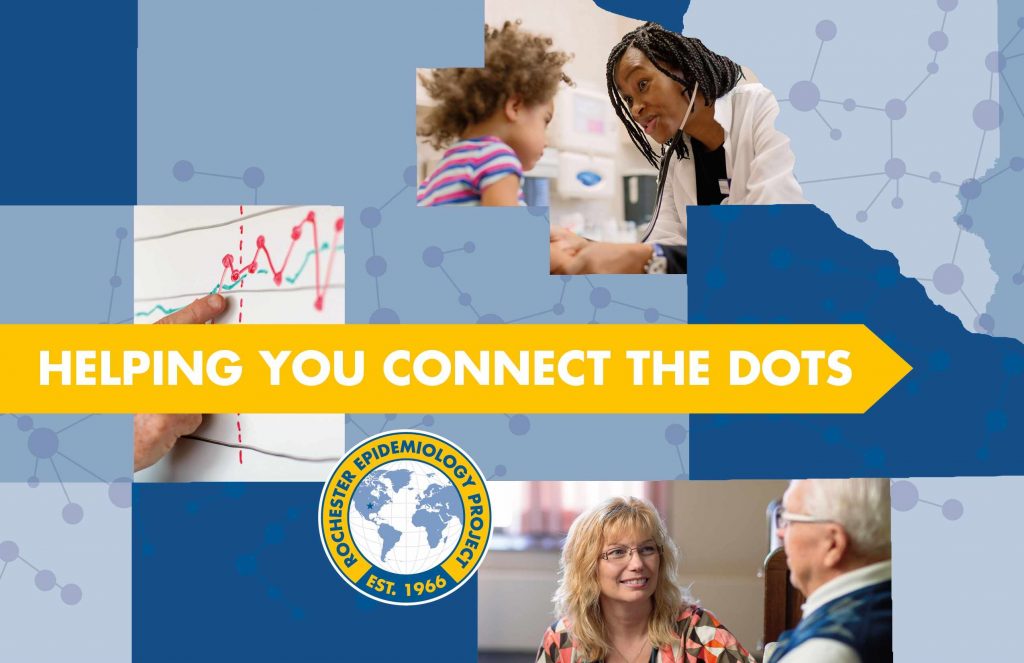 ROCHESTER, Minn.— After celebrating its 50th anniversary in May 2016, the Rochester Epidemiology Project team is not stopping to rest. Instead, they are marking the beginning of the next 50 years with the launch of a tool that could change community and public health in the region.
ROCHESTER, Minn.— After celebrating its 50th anniversary in May 2016, the Rochester Epidemiology Project team is not stopping to rest. Instead, they are marking the beginning of the next 50 years with the launch of a tool that could change community and public health in the region.
The Rochester Epidemiology Project’s new Data Exploration Portal places regional disease prevalence data at the fingertips of health care providers and researchers. It pulls from the database that includes nearly all health information for Olmsted County, Minnesota, residents back more than 50 years. Medical records from a large contingent of the residents of 26 surrounding counties in Minnesota and Wisconsin also are in the database.
Exploring the data in this free-to-access tool will enable medical researchers to compare and correlate the prevalence of different conditions and determine if there is something to investigate. They can find age- or sex-specific information, identify geographic clusters and determine if data are available to support their hypothesis.
Public health agencies can use the Data Exploration Portal to narrow their focus to the conditions most relevant to their communities.
“Knowing what conditions are most common in our communities helps us plan programs and allocate funds in an efficient manner,” says Pete Giesen, director, Olmsted County Public Health Services.
Primary and community care providers can identify potential patient needs and better personalize care.
“The new data exploration portal will provide information about whether a particular condition exists in a geographic area,” stated Kathryn Lombardo, M.D., president of Olmsted Medical Center. “For clinicians, this means we will be able to better determine the likelihood that two different clinical conditions could occur together. And, at point-of-care, it will help us determine what questions may need to be asked of our patients and, ultimately, enable us to provide more personalized care.”
Patients, too, can find the portal informative as they seek to learn more about their disease.
“A patient recently diagnosed with multiple sclerosis can find out how common the disease is in the area and know that she is not alone,” says Walter Rocca, M.D., a neurologist and epidemiologist at Mayo Clinic, and co-director of the Rochester Epidemiology Project. “A son whose father has Parkinson’s disease can learn how common the disease is and how the risk increases with age, and is greater for men.”
“Much like what we can do from a public health perspective, advocacy groups may use the Rochester Epidemiology Project’s Data Exploration Portal to help define the health landscape and identify diseases and conditions that appear together,” says Giesen. “This could lead to new education, outreach or collaboration opportunities.”
“The Rochester Epidemiology Project Data Exploration Portal provides a new way to examine the occurrence of diseases and facilitate prevention in our community,” says Dr. Rocca. “We are excited to be able to share some of the data and to see what other insights it will bring to community health and wellness.”
Learn more about the Rochester Epidemiology Project’s history by viewing its historical timeline – a new interactive online display. In addition, rochesterproject.org contains information on the more than 2,600 publications that have resulted from research based on Rochester Epidemiology Project data. It also has information for current and potential researchers, as well as news and community resources.
###
About the Rochester Epidemiology Project
The Rochester Epidemiology Project is a collaboration of clinics, hospitals, and other medical and dental care facilities in southern Minnesota and western Wisconsin. It was founded by Mayo Clinic and Olmsted Medical Center in 1966 in Olmsted County, Minnesota. The collaboration now includes Olmsted County Public Health Services as its first public health member, and stretches across 27 counties. This collaboration and sharing of medical information makes this area of Minnesota and Wisconsin one of the few places where true population-based research can be accomplished. For more information, visit rochesterproject.org.
About Mayo Clinic
Mayo Clinic is a nonprofit organization committed to clinical practice, education and research, providing expert, whole-person care to everyone who needs healing. For more information, visit mayoclinic.org/about-mayo-clinic or newsnetwork.mayoclinic.org.
MEDIA CONTACTS
Elizabeth Zimmermann Young, Mayo Clinic Public Affairs, 507-284-5005, newsbureau@mayo.edu
Kari Etrheim, Olmsted County Public Health Services, 507-328-7424, etrheim.kari@co.olmsted.mn.us
Barb Sorensen, Olmsted Medical Center, 507-292-7203, bsorensen@olmmed.org







